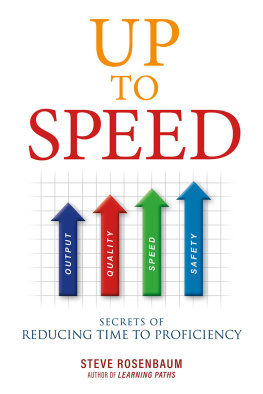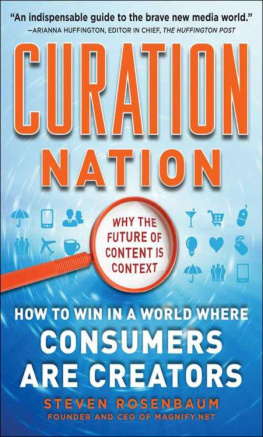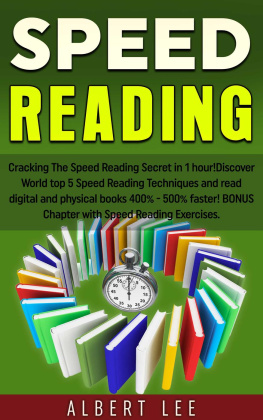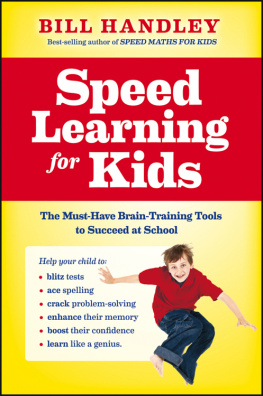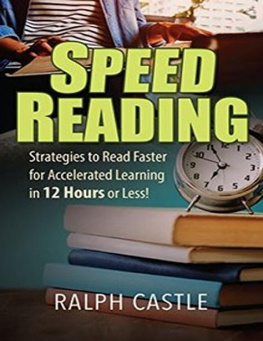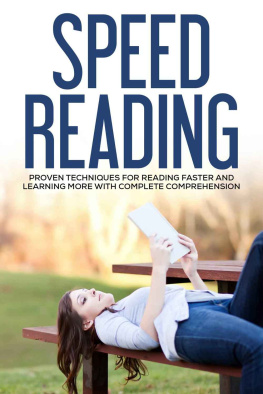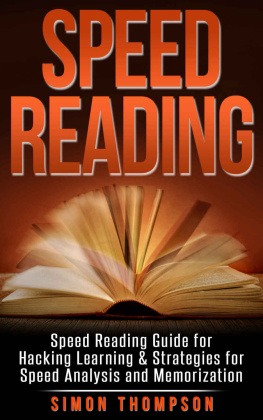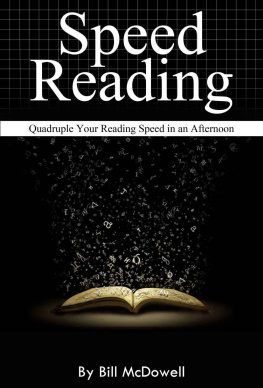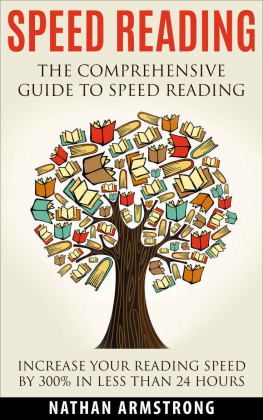
Up to Speed : Secrets of Reducing Time to Proficiency
Copyright 2018 by Steve Rosenbaum
All rights reserved. This book or any portion thereof may not be reproduced or used in any manner whatsoever without the express written permission of the publisher except for the use of brief quotations in a book review.
ISBN (Print Edition): 978-1-54392-925-6
ISBN (eBook Edition): 978-1-54392-926-3


I first became acquainted with Steve Rosenbaums work shortly after the first publication of our own book The Six Disciplines of Breakthrough Learning. The Six Disciplines was the result of our effort to understand why some companies get so much better results from learning and development than others. The secret, we found, was in focusing on business needs and treating training as a process, rather than in chasing the latest trend or having the most gee-whiz technology.
When I met Steve and learned more about the Learning Paths methodology, I knew I had found a kindred spirit: someone with a pragmatic approach and fresh ideas for getting greater business value from investments in training and development. In the years since, I have had many long conversations with Steve (those who know him, know such conversations are rarely short) about the opportunities for making training much more effective and valuable.
I have benefited greatly from his insights, humor, wisdom, and deep experiencethe result of implementing Learning Paths across a wide range of industries, jobs, and geographies. Now, in this long-awaited sequel to the original Learning Paths book, Steve distills that wisdom and shares the lessons he has gleaned from another dozen years of experience.
The pivotal insight of Learning Paths is, as its name implies, the recognition that there is a pathway from novice to journeyman, from an unskilled to a proficient performer. Getting to competence is a journey; it cannot be accomplished in a single leap or as the result of a few-day or even a few-week training program. Proficiency develops over time, through multiple learning experiences, practice, and feedback.
As with any journey, some routes are more efficient than others. Some are direct; others are tortuous with needless delays and detours. Some paths are well-marked with clear milestones; others are unmarked and hopelessly confusing so that you never know where you are. The job of corporate learning professionals is to help define, design, implement, and manage the optimal pathway to enable employees to complete the journey to proficiency as quickly, efficiently, and consistently as possible.
Steve is adamant that training professionals need to be clear about what they fundamentally believe about learning since that determines how they approach their jobs. Once, when we were making a joint presentation at the Association for Talent Development, Steve began the seminar by asking: What do you truly believe to be true about learning? We were greeted by blank looks. Apparently, few had ever thought deeply about the question. In this new edition of Learning Paths, he suggests some principles to consider.
One is that knowing is not the same as doing. Although he began his career as an instructional designer, well-steeped in ADDIE and learning objectives, Steve has never lost sight of the real raison d tre of corporate learning: to help the business achieve its objectives. To accomplish business goals, employees need to do their jobs competently, safely, and well; it is not enough that they know how. Value is created by doing rather than just knowing. Thus, the Learning Paths approach focuses on what employees need to do and the best and most efficient way for them to learn that.
A well-designed learning path includes all the learning experiences that an employee needs to perform his or her job competently. Unfortunately, most organizations still approach training as a one-and-done training event, in which the end of the class is the end of the journey. Some years ago, I was an invited instructor at one of the most famous corporate leadership development centers. Over dinner, I asked a group of participants in the Management Development Program, What are you expected to do with what you have learned when you return to work? They looked at me as if I had two heads. Do? they asked. It never occurred to them that they were expected to do anything afterward. The path (and the learning) dead-ended at the classroom door. In contrast, a proper Learning Path leads all the way to the destination: competent on-the-job performance.
The Learning Paths approach is not about training philosophy; its about business results. A well-designed learning path shortens the time before an employee becomes a net contributor, rather than a net cost, to the organization. It also generates significant savings in recruiting and onboarding costs; employees who are more productive more quickly are more likely to stay with the organization. In a large organization, an effective learning pathas opposed to traditional onboarding approachescan save millions of dollars.
The second key principle of Learning Paths is that learning how to do a job should occur by design, not by accident. Given the very real costs and risks associated with incompetent performance, it is a mistake to simply hope that employees will pick up critical skills on the job or by osmosis. There is simply too much variability in what they experience. And variability, as the great quality guru, W. Edwards Deming, taught us, is the enemy of quality. Saying that learning should occur by design, is not to say by any means, that all skills require classroom or computer-based training. Quite the contrary: on-the-job coaching, mentoring, and just-in-time learning are vital parts of any learning path. The point is that all the essential learning experiences need to be planned and executed with the same care and attention that has traditionally been lavished on classroom and e-learning events.
A final strength of the Learning Paths approach is its emphasis on continuous process improvement. No path is perfect and, as Will Rogers pointed out, Even if you are on the right track, you will get run over if you just sit there. The application of process improvement philosophies and methodologies to manufacturing has resulted in higher-quality products at lower costs than at any time in history. Applying these same techniques to training and development likewise improves quality and reduces cost. Process improvement, however, depends on having a clear definition of the quality of the output and methods to measure it. Learning Paths provides the answers: quality from training is defined as the ability to perform independently to the required standard for a given job. The key metric is the time to achieve that level of performance (time to Independence Day, as Steve like to call it). In the Learning Paths approach, the results of the current process are monitored, and opportunities to improve the process are proposed and implemented. The results are assessed, and further improvements are identified based on the results: a classic Deming PDCA Cycle.
Given that the benefits of implementing Learning Paths are documented, obvious, and compelling, why hasnt the approach been universally applied in corporate training and development? The main hurdle is our own mindset. For years, learning professionals and business leaders alike have seen the role of training as delivering training . As such, we have tracked, scored, reported, and rewarded the number of hours of training and whether people enjoyed it. In fact, the real job of training and development, as Steve points out, is to enhance employee performance, achieve business goals, and create competitive advantage. The company that does that most effectively and efficiently wins.

